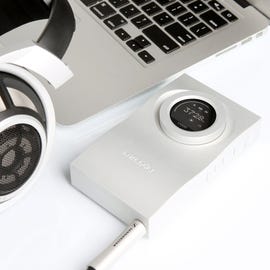First impression: the Aurender Flow looks and feels like a high-end component. The impeccably finished solid aluminum case, big volume control knob, and all-metal control buttons let you know this is the real deal. As for sound quality, it’s spectacular!

Aurender
Connectivity is limited to just one USB 3 port and an optical digital input, plus a 6.3mm headphone jack. Flow handles up to 192 kHz/24-bit digital files via the optical connection (more about that later), and ultra-high resolution 384kHz/32-bit and DSD128 files via USB. There are no analog inputs.
Measuring 3.1 x 5.4 x 1.1 inches (80 x 137 x 28mm) and weighing one pound (450 grams), the Flow is a little too big to stuff in your pocket. I used it mostly as a desktop digital converter/headphone amp; some Flow owners might take it to work, or on long flights. The Flow comes with a handsome leather carrying case.
The big volume control makes it easy to get to exactly the volume I want with a flick of the wrist. The 4,450mAh battery’s play time tops out at 7 hours; at home you can charge the battery as you listen. If you own a large library of music, you can take a lot of it with you by installing an mSATA drive (up to a 1TB) inside the Flow. (The Flow is a digital converter/headphone amp, not a music player like an Astell & Kern or Pono.)
Since the Flow sports a 6.3mm headphone jack, I started listening with my AKG K812 full-size headphones. The sound was sweet, highly detailed, massively spacious, and the midrange tonality was oh-so natural. I immediately settled down and just relished the sound. When I’m writing a review, I’m usually comparing one product to another, but this time I just wanted to take it all in. The Flow was that good!
Most of the time I played the Flow hooked up to my Mac mini, but I also listened with my Oppo BDP-105 Blu-ray player, via the Flow’s optical input. While the Flow is supposed to play up to 192 kHz/24-bit files, it didn’t, though 96 kHz/24-bit files were no problem. So I checked with Aurender’s Division Director Harry Lee, and he confirmed there were compatibility issues for 192 kHz/24-bit files via the optical input with some players. However, the 96 kHz/24-bit files sounded great.
More Audiophiliac
I spent most of the time listening to standard-resolution Apple Lossless and FLAC files. After all, most potential buyers will own a lot more standard-resolution files than high-resolution ones. The sound feels incredibly precise, but never cold or overly analytical. The new Audeze EL-8 headphone’s clarity was excellent while listening to streaming FLAC files from Tidal Music.
My Shure SE846 in-ear headphones sounded faster, more dynamic and open with the Flow than any other amp I’ve tried. The Centrance Hi-Fi M8 amp had a leaner presentation; the Flow had a fuller, richer balance, which I preferred. The Flow had no problem driving my very high-impedance (600 Ohm) Beyerdynamic T-1 headphones.
I wish I still had the Chord Hugo portable DAC/amp to compare with the Flow, but as memory serves Hugo was more transparent and clear, but it’s also bigger and twice as expensive as the Flow.
The Aurender Flow’s US price is $1,295 from the company’s Web site, and it’s available through a small network of US dealers; in Australia, it’ll run you AU$1,799.



